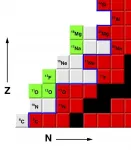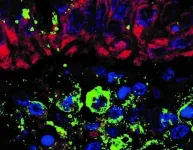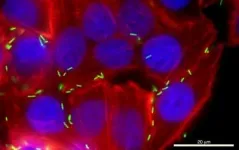Status of greater sage-grouse populations
New research highlights decline of greater sage-grouse in the American West, provides roadmap to aid conservation
2021-03-30
(Press-News.org) RESTON, Va. - Greater sage-grouse populations have declined significantly over the last six decades, with an 80% rangewide decline since 1965 and a nearly 40% decline since 2002, according to a new report by the U.S. Geological Survey. Although the overall trend clearly shows continued population declines over the entire range of the species, rates of change do vary regionally.
The report represents the most comprehensive analysis of greater sage-grouse population trends ever produced and lays out a monitoring framework to assess those trends moving forward. The study can also be used to evaluate the effectiveness of greater sage-grouse conservation efforts and analyze factors that contribute to habitat loss and population change -- all critical information for resource managers.
"Every day, the USGS brings diverse stakeholders the compelling science they need to make strategic, on-the-ground policy and management decisions," said David Applegate, associate director exercising the delegated authority of the USGS director. "With this framework in place, resource managers can more nimbly respond to population declines with actions such as redistributing monitoring efforts or prioritizing where management intervention may be needed."
USGS scientists and colleagues developed the framework to estimate greater sage-grouse population trends in the 11 western states where the species lives - California, Colorado, Idaho, Montana, Nevada, North Dakota, Oregon, South Dakota, Utah, Washington and Wyoming. The greater sage-grouse is a vulnerable species and an indicator of the overall health of the iconic sagebrush ecosystem.
The research found that in recent decades the rate of greater sage-grouse decline increased in western portions of the species' range, particularly in the Great Basin, while the declines have been less severe in eastern areas. Western Wyoming was the only region to show relatively stable sage-grouse populations recently. Taken as a whole, the greater sage-grouse population now is less than a quarter of what it was more than 50 years ago.
To complete the framework, USGS and Colorado State University researchers collaborated with the Western Association of Fish and Wildlife Agencies, individual state wildlife agencies and the Bureau of Land Management. Together, they compiled information and created a rangewide database of greater sage-grouse breeding grounds. Researchers used that information to assess past and current sage-grouse population trends in different parts of the species' range.
In addition to the database and population-trend assessment, researchers also developed a "Targeted Annual Warning System" to alert biologists and managers when local greater sage-grouse populations begin to decline or have diverged from regional trends. The research identified the most at-risk breeding grounds, with the greatest risk seen at the periphery of the species' range. The report shows that there is only a 50% chance that most breeding grounds, called leks, will be productive in about 60 years from now if current conditions persist. USGS scientists will continue to analyze information to determine the factors driving changes in breeding areas and populations, including the influence of habitat loss and degradation.
"The framework we developed will help biologists and managers make timely decisions based on annual monitoring information," said Peter Coates, USGS scientist and lead author of the report. "This will allow them to address local issues before they have significant impacts on the population."
INFORMATION:
For more details about "Range-Wide Greater Sage-Grouse Hierarchical Monitoring Framework," read the full report [link].
USGS provides science for a changing world. For more information, visit http://www.usgs.gov.
ELSE PRESS RELEASES FROM THIS DATE:
2021-03-30
(Philadelphia, PA) - The human heart works under high demand, constantly pumping oxygen-rich blood through the body. When faced with disease, however, fulfilling this demand can become increasingly difficult and harmful. In the case of chronic high blood pressure - a leading cardiovascular disease in the United States - the heart continuously overexerts, resulting in maladaptive growth and, ultimately, severe dysfunction of the heart muscle itself.
Maladaptive growth of the heart, known as cardiac hypertrophy, is brought about in part by activation of G protein-coupled kinase ...
2021-03-30
Researchers at Washington University in St. Louis reported the first observations of a new form of fluorine, the isotope 13F, described in the journal Physical Review Letters.
They made their discovery as part of an experiment conducted at the National Superconducting Cyclotron Laboratory at Michigan State University (MSU).
Fluorine is the most chemically reactive element on the periodic table. Only one isotope of fluorine occurs naturally, the stable isotope 19F. The new isotope, 13F, is four neutrons removed from the proton drip line, the boundary that delimits the zone beyond which atomic nuclei decay by the emission ...
2021-03-30
CAMBRIDGE, MA -- More than just a sign of illness, mucus is a critical part of our body's defenses against disease. Every day, our bodies produce more than a liter of the slippery substance, covering a surface area of more than 400 square meters to trap and disarm microbial invaders.
Mucus is made from mucins -- proteins that are decorated with sugar molecules. Many scientists are trying to create synthetic versions of mucins in hopes of replicating their beneficial traits. In a new study, researchers from MIT have now generated synthetic mucins with a polymer backbone that more accurately mimic the structure and function of naturally occurring mucins. The team also showed that these synthetic mucins could effectively neutralize the bacterial toxin that causes cholera.
The ...
2021-03-30
A study conducted at the University of Campinas (UNICAMP) in the state of São Paulo, Brazil, shows that compounds produced by gut microbiota (bacteria and other microorganisms) during fermentation of insoluble fiber from dietary plant matter do not affect the ability of the novel coronavirus SARS-CoV-2 to enter and replicate in cells lining the intestines. However, while in vitro treatment of cells with these molecules did not significantly influence local tissue infection, it reduced the expression of a gene that plays a key role in viral cell entry and a cytokine receptor that favors inflammation.
An ...
2021-03-30
HERSHEY, Pa. -- Stress, increased free time and feelings of boredom may have contributed to an increase in the number of cigarettes smoked per day during the early months of the COVID-19 pandemic by nearly a third of surveyed Pennsylvania smokers. Penn State College of Medicine researchers said understanding risk factors and developing new strategies for smoking cessation and harm reduction may help public health officials address concerning trends in tobacco use that may have developed as a result of the pandemic.
Jessica Yingst, assistant professor of public health sciences and Penn State Cancer Institute researcher, said smokers who increased the number of cigarettes they smoked per day could be at greater risk of dependence and have a more difficult ...
2021-03-30
March 30, 2021 - As cancer survival rates improve, more people are living with the aftereffects of cancer treatment. For some patients, these issues include chronic radiation-induced skin injury - which can lead to potentially severe cosmetic and functional problems.
Recent studies suggest a promising new approach in these cases, using fat grafting procedures to unleash the healing and regenerative power of the body's natural adipose stem cells (ASCs). "Preliminary evidence suggests that fat grafting can make skin feel and look healthier, restore lost soft tissue volume, and help alleviate pain and fibrosis in patients with radiation-induced skin injury ...
2021-03-30
Giant trees in tropical forests, witnesses to centuries of civilization, may be trapped in a dangerous feedback loop according to a new report in Nature Plants from researchers at the Smithsonian Tropical Research Institute (STRI) in Panama and the University of Birmingham, U.K. The biggest trees store half of the carbon in mature tropical forests, but they could be at risk of death as a result of climate change--releasing massive amounts of carbon back into the atmosphere.
Evan Gora, STRI Tupper postdoctoral fellow, studies the role of lightning in tropical forests. Adriane Esquivel-Muelbert, lecturer at the University of Birmingham, studies the effects of climate change in the Amazon. The two teamed up ...
2021-03-30
PULLMAN, Wash. - Washington State University researchers have discovered a protein that could be key to blocking the most common bacterial cause of human food poisoning in the United States.
Chances are, if you've eaten undercooked poultry or cross contaminated food by washing raw chicken, you may be familiar with the food-borne pathogen.
"Many people that get sick think, 'oh, that's probably Salmonella,' but it is even more likely it's Campylobacter," said Nick Negretti ('20 Ph.D.), a lead member of the research team in Michael Konkel's Laboratory in WSU's School of Molecular Biosciences.
According to a study on the research recently published ...
2021-03-30
PROVIDENCE, R.I. [Brown University] -- Researchers from Brown University have discovered a previously unknown type of ancient crater lake on Mars that could reveal clues about the planet's early climate.
In a study published in Planetary Science Journal, a research team led by Brown Ph.D. student Ben Boatwright describes an as-yet unnamed crater with some puzzling characteristics. The crater's floor has unmistakable geologic evidence of ancient stream beds and ponds, yet there's no evidence of inlet channels where water could have entered the crater from outside, and no evidence ...
2021-03-30
Judges don't do court stenography. CEOs don't take minutes at meetings. So why do we expect doctors and other health care providers to spend hours recording notes -- something experts know contributes to burnout?
"Having them do so much clerical work doesn't make sense," said Lisa Merlo, Ph.D., an associate professor of psychiatry and director of wellness programs at the University of Florida College of Medicine. "In order to improve the health care experience for everyone, we need to help them focus more on the actual practice of medicine."
Physician burnout affects patients, too. Stressed doctors are less compassionate and more likely to make mistakes. Clinicians who leave the field or cut back hours reduce patient access ...
LAST 30 PRESS RELEASES:
[Press-News.org] Status of greater sage-grouse populations
New research highlights decline of greater sage-grouse in the American West, provides roadmap to aid conservation




